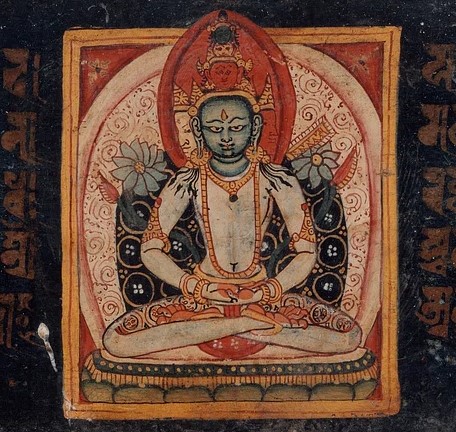In my last column, I provided a brief history of the attempt to anthologize Buddhist texts, to reduce the teachings of Buddhism to a single volume. The organization of these anthologies was often telling, revealing the presuppositions and prejudices of the editors. Some were chronological, beginning with Pali texts (believed to be the earliest sources) and moved on to Indian Mahayana, then to China, and sometimes Tibet, and ended with some works of Japanese Zen. Tibet was almost neglected in this schema: because of the paucity of Tibetan translations, anthologizers drew inevitably from The Tibetan Book of the Dead or The Life of Milarepa. The president of the Buddhist Society of London, Christmas Humphreys augmented the Tibetan materials in The Wisdom of Buddhism (1960) with a selection from Madame Blavatsky’s The Voice of the Silence, a work scholars regard as her own fabrication.
But whether these works were organized by chronology, by country of origin, or by vehicle, the great anthologies of Buddhist texts produced over the last century were dominated by works that came from India and from Pali, and regardless of their source, placed a heavy emphasis on doctrine, philosophy, and the practice of male elites. These anthologies thus did not represent the practices of most Buddhists around the world and through history. In 1991, I undertook the audacious task of putting together a new anthology of Buddhist texts, entitled Buddhism in Practice. Instructed by the lessons of previous anthologies, my intention, at least, was to do something different. First, I decided to exclude works that had been previously translated, especially those that were considered classics. There would be no Dhammapada, no Diamond Sutra, no Heart Sutra. Furthermore, I would try to represent the Theravada not with works from the Pali canon but with vernacular works from Southeast Asia. Although there would be works from India, China, and Japan, there would also be material from the often marginalized Buddhist traditions of Korea, Nepal, Tibet, Thailand, and Burma.
Another element common to anthologies that I decided to exclude was philosophical texts. Buddhism has a vast literature dealing with what we term logic, epistemology, and ontology—works that are (depending on one’s perspective) as profound or as impenetrable, as rich or as arid, as anything produced in the West. But like philosophical works in other cultures, Buddhist treatises are the products of a tiny, highly educated elite (largely composed of monks) and their works rarely touch the ground where the vast majority of Buddhists have lived their lives. The emphasis of the new anthology would be practice, especially in the ordinary sense of the term. Moreover, new works of philosophy seemed somewhat redundant; because Western scholars have shown a strong interest in Buddhist philosophical writings over the last century, many translations and studies are already available. Instead, in Buddhism in Practice, I tried to represent types of discourse (including ritual manuals, folktales, prayers, sermons, pilgrimage songs, and autobiographies) and voices (vernacular, esoteric, domestic, and female) that have not been sufficiently represented.
But these were only general principles. With the classics now excluded, the more difficult task was deciding which works to include; there were thousands of untranslated choices available. To identify texts and then to commission their translation seemed both ideologically problematic (because of the omniscience it would imply) and logistically impossible (because scholars work on what they are working on, not what they are asked to work on). Instead, I decided to try to exploit the unavoidably random nature of anthologies by contacting a group of highly regarded scholars—especially younger scholars—and asking them what they had on their hard disks, either from dissertations or from current research. The implication of such an approach is that the “canon” is the aggregate of what scholars are studying, teaching, and, in this case, translating at a given moment.
The task of the anthologizer is not simply one of selection, but also of narration. In the end, I decided to organize the forty-eight selected works not according to academic categories of chronology or geography, but according to the most traditional of Buddhist categories, the three jewels of the Buddha, the dharma, and the sangha. A Buddhist is defined as someone who takes refuge in the three jewels, and the refuge ceremony is the most widely performed practice in the Buddhist world. Buddhism in Practice was organized under these three headings both to reflect this most traditional of Buddhist categories and to call these categories into question by demonstrating the myriad ways in which Buddhists have answered the questions: Who is the Buddha? What is the dharma? And who belongs to the sangha? This organization also provided an opportunity to juxtapose materials from different vehicles, historical periods, and geographical regions that are often regarded as distinct and discontinuous, in an attempt to broaden the range of what we understand Buddhism and the practice of Buddhism to be.
Any book, and especially any anthology, is inevitably a product of its times; Buddhism in Practice reflects current concerns with popular rather than elite practice, with ritual rather than philosophy, with voices from the margin rather than those that speak from the center. But sometime soon, someone will be compelled to undertake a new anthology of Buddhist texts, another futile, but not unrewarding, attempt to digest the dharma.
Thank you for subscribing to Tricycle! As a nonprofit, we depend on readers like you to keep Buddhist teachings and practices widely available.
